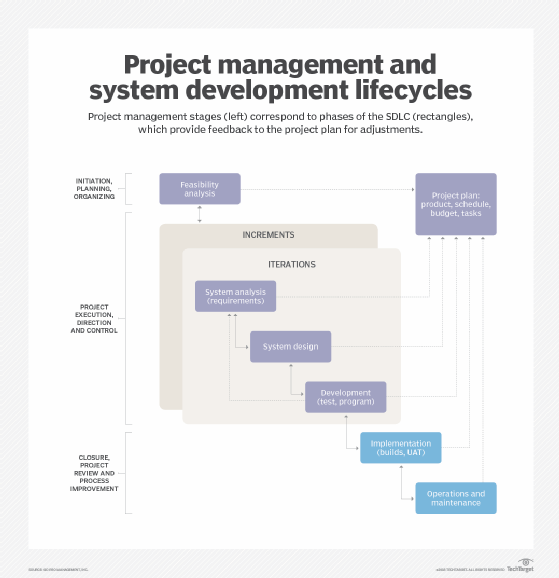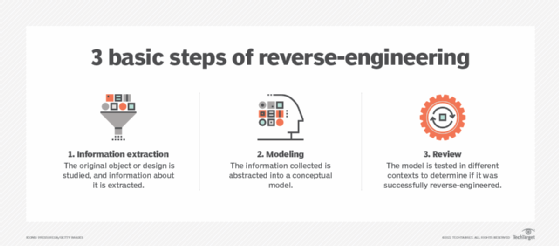iterative
What is iterative?
In the world of IT and computer programming, the adjective iterative refers to a process where the design of a product or application is improved by repeated review and testing.
In programming specifically, iterative refers to a sequence of instructions or code being repeated until a specific end result is achieved. Iterative development is sometimes called circular or evolutionary development. Each single pass through the sequence to complete all the steps in the given order is known as an iteration. If the sequence of instructions is executed repeatedly, it is called a loop, and the computer is said to iterate through the loop. Almost all computer programs are executed by using iterations and loops to execute specific tasks and provide solutions to problems.
In product engineering and project management, a designer produces a draft or sample intended to meet the core needs of the customer or user. That design is then revisited and fine-tuned multiple times by the designer and project owner until the best possible version is achieved.
What is an iterative process?
Any iterative process is the practice of refining and improving a product, process, idea or initiative through multiple iterations. These iterations are part of a cyclical process where steps are repeated, rather than a linear process where each step happens only once.
In an iterative environment, teams create, test and revise their product or solution until they reach a consensus about the quality of the end result or deliverable. Thus, in some ways, an iterative process is a type of trial-and-error method of repeated changes and improvements to achieve a project's stated goals.

Iterative development in software development
In software development, iterative describes a heuristic planning and development process. Such processes are critical in Lean software development and Agile project management, although non-Lean and non-Agile teams can also implement iterative processes.
In iterative software development, an application is developed in small sections called iterations. The goal of the process is usually to refine or tweak the latest version or iteration of the product to make a subsequent version that better meets the product's goals and objectives.
The development and testing team -- and, sometimes, end users -- review each iteration. They also critique it to find bugs or functionality errors. Any insights gained from the critique help determine the next step in development. Those insights also improve the quality of the product before it can be released to users or customers.
One challenge is to make sure that all the iterations are compatible. To do this, developers may employ reverse-engineering as each new iteration is approved. This is a technique that involves systematic iteration reviews and check procedures to ensure compatibility.
Data models or sequence diagrams are used to map out the various iterations. They also help development teams track what has been tried, approved or discarded. Eventually, these models and diagrams serve as a type of blueprint for the final product.

Types of iterations in computer programming
In computer programming, iterations enable programmers to streamline design and development, since they know that definite steps will be repeated and many irrelevant steps will be removed. The steps that are part of the loop will be repeated. To show this repetition, they are indented in the code.
The two main types of iterations are the following.
Count-controlled loops
In this loop, iterations happen a specific number of times. In this case, the count is already known. It is executed using FOR statements, where for specifies the iteration's starting point and range indicates the number of iterations. Also, a variable count regulates the repetition. A count-controlled loop uses a counter to track the number of times a command has been repeated.
Condition-controlled loops
In these loops, iterations happen continuously until a specific condition is met, at which point they will stop. This loop is commonly used when the number of iterations needed are unknown.
Condition-controlled loops are executed using WHILE statements, which is where the iteration starts. The code executes a particular set of commands depending on the state of conditions -- true or false. If the condition is true, the program repeats, but if it is false, it goes to the next step.
Iterative process vs. incremental design
Often, the terms iterative process and incremental design are used interchangeably in IT and software development. However, there are differences between these approaches.
Iterative processes involve refining and improving a software project or product based on received feedback or new information. The goal is to achieve continuous improvement by incorporating changes in a trial-and-error fashion.
In incremental design, new features are built on top of an existing version as an update or upgrade. Teams using this approach may deliberately introduce a bare-bones version of a product to speed up time to market, resulting in what is often called a minimum viable product.
Once the product is delivered, teams upgrade it by adding new features and functionalities. They then keep adding new features until the product matches the original plan and has all the features it needs to have.
Some teams may also incorporate customer feedback as they add new features. In this sense, incremental design is also iterative.
Applications of iterative processes
Examples of how iterative processes are used include the following:
- Marketing. Iterative processes are used to test which advertising copy is performing better in terms of user engagement, to identify which brand imagery resonates with the audience, and to see which email newsletter gets higher click-through rates.
- Sales. Sales teams may use iterative processes to identify the best email subject lines in terms of opens by prospective customers.
- Engineering. Engineering teams use iterative processes for A/B testing, bug fixes and new feature development based on customer pain points or needs.
Benefits of iterative processes
Iterative processes deliver many benefits in a variety of settings:
- Improved efficiency. By iterating, teams can better understand what is working and what is not to improve the efficiency of the overall system.
- More cost-effective. It's cheaper to make continual small changes instead of making a costly, big-bang change at the end of the development process. Moreover, any scope changes require only minimal cost and effort.
- Improved communication and collaboration. Teams can work together to identify and fix issues in a collaborative environment, which improves communication, minimizes mistakes and reduces errors.
- Shorter timelines. Not all iterations depend on previous steps, so team members can work on different elements in parallel, thereby speeding up development and shortening the overall project timeline.
- Reduced risk and faster problem-solving. Instead of waiting until the final product is available, problems are identified and solved early and at each stage of development. This prevents issues from escalating and causing bigger issues later.
- Involvement of end users. Often, end users are involved in the development process, which helps create an effective and reliable feedback loop for improvements. It also creates products that more closely match user or market needs and demands.
See iterative and incremental development explained. Also, read how to deliver software with a software development lifecycle iterative model and how iterative development enables software teams to get just-in-time requirements.







